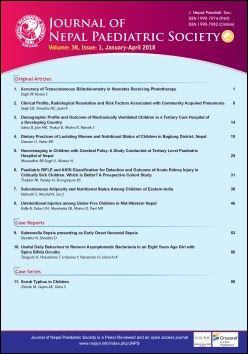Dietary Practices of Lactating Women and Nutritional Status of Children in Baglung District, Nepal
DOI:
https://doi.org/10.3126/jnps.v38i1.19513Keywords:
Dietary practices, lactating mothers, feeding practices, children, nutritional statusAbstract
Introduction: Breastfeeding success depends on both mother and child. There is high energy requirement to produce breast milk, which is wholesome food for under 6 months children and then complementary foods are introduced to child. Inadequate feeding practices affect nutritional status of children. The main aim of this study was to measure the dietary practices of lactating women and nutritional status of their children.
Material and Methods: A cross sectional study was conducted among 343 lactating women and under two years children of Baglung district. Random sampling technique was applied to select the participants. Face to face interview was conducted among women to collect the data and anthropometric measurement was performed among the children. Data were entered in EPI-DATA version 3.2 and exported to Statistical Package for Social Sciences (SPSS version 17.0) for further analysis.
Results: Only 5.2% of mother had taken additional two meals per day and energy intake of 31.8% of women was met. Dietary practices of mothers were not associated with nutritional status of children. Breastfeeding practice was nearly universal (99.7%). Bulks (91.8%) of children were put into breast for breast feeding within first hour of birth. Exclusive breastfeeding rate was 34.5%. Bottle feeding was practiced by 15.6% of women. Less than half (40%) of 6-23 months children (n=174) had achieved satisfactory feeding practice (minimum meal frequency and minimum dietary diversity). The rate of wasting (n=180), stunting (n=180) and underweight (n=343) was 10%, 22.2% and 9.3% respectively. Feeding practice to children was associated with wasting and stunting.
Conclusion: Dietary practice of women and feeding practice to their children was not satisfactory. Dietary practice of women was not associated with nutritional status of children but feeding practice was associated with their nutritional status. The rate of stunting, wasting and underweight was high.
Downloads
Downloads
Additional Files
Published
How to Cite
Issue
Section
License
Authors who publish with this journal agree to the following terms:
Authors retain copyright and grant the journal right of first publication with the work simultaneously licensed under a Creative Commons Attribution License that allows others to share the work with an acknowledgement of the work's authorship and initial publication in this journal.
Authors are able to enter into separate, additional contractual arrangements for the non-exclusive distribution of the journal's published version of the work (e.g., post it to an institutional repository or publish it in a book), with an acknowledgement of its initial publication in this journal.
Authors are permitted and encouraged to post their work online (e.g., in institutional repositories or on their website) prior to and during the submission process, as it can lead to productive exchanges, as well as earlier and greater citation of published work (See The Effect of Open Access).



